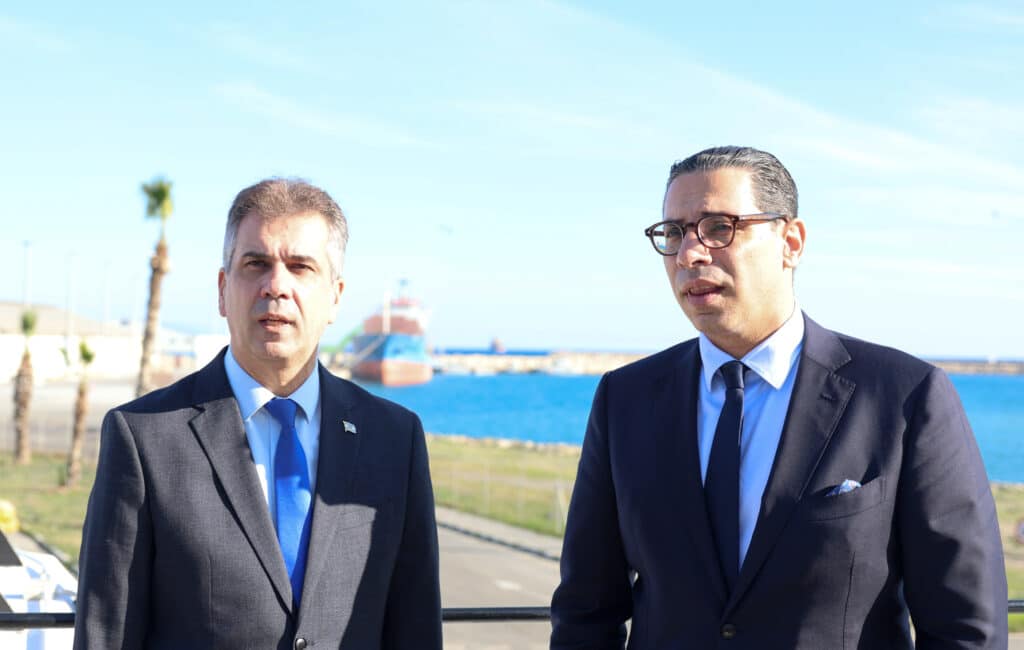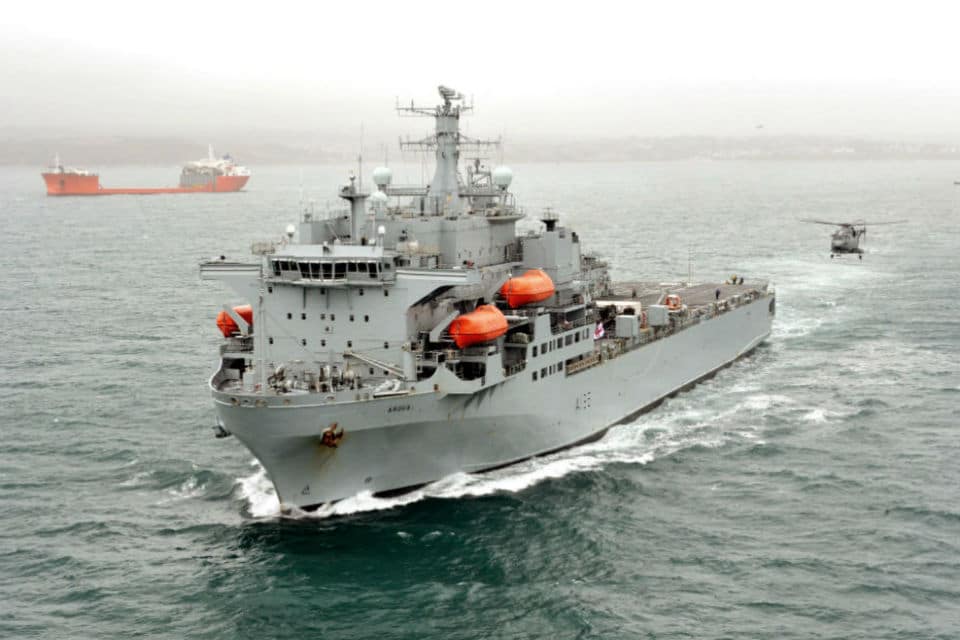What happened to the ship with the first cargo? How long will planned corridor operate for? How the aid operation will unfold remains unanswered
Over two months since Cyprus first floated the idea for a maritime humanitarian corridor to Gaza, questions hang over the feasibility of the mooted operation, the whereabouts of the British landing ship, and even the purpose of the corridor – a temporary arrangement providing aid to the besieged strip during the hostilities, or a more permanent setup enabling Israel to ‘wash its hands’ of the Palestinian territory.
The British ship reported to have begun these operations, the RFA Lyme Bay, has comings and goings that have become something of a mystery. It reportedly docked at Larnaca port on December 16, departing – destination unknown – on the same day. Follow-up media reports said the vessel did not make it to Israel/Gaza, and that it was ‘stuck’ in international waters due to complications, presumably from the Israeli side. The ship was reportedly loaded with 80 tonnes of aid – a drop in the bucket.
That story was rather implausible, as logically the vessel would have had clearance beforehand to travel to Israel/Gaza.
But it’s also unclear if the Lyme Bay ever docked in Larnaca. There’s no independent corroboration of that, no photograph. What photographic evidence does exist concerns the RFA Argus, the vessel named as accompanying the Lyme Bay for the Gaza aid operation. According to the same X (Twitter) post by Navy Lookout, the Lyme Bay sailed from Cyprus on December 16, but from Limassol, not Larnaca.

The Lyme Bay went into ghost mode after the December 16 media reports. The vessel pinged off the coast of Spain, then Bahrain, off the coast of Morocco, Barbados, the Gulf of Oman, and Barbados again. Obviously the ship’s transponder was scrambled – expected whenever a military naval asset is on deployment.
On December 22 the Lyme Bay was spotted in Valetta, Malta. A contact with an eyewitness source in Malta told the Cyprus Mail that the ship left there on December 26. Since then, it has gone ‘dark’ again.
Three days earlier, December 19, during a UK parliamentary session British Undersecretary of State Andrew Mitchell said: “Lyme Bay is loaded with supplies in Cyprus, and is ready to sail once we can be assured that the support can be received and delivered.”
If the ship was in fact “in Cyprus” or “off Cyprus” on December 19, as stated by British officials, could it have made it to Malta by December 22? Considering its speed, it could. But why not stay here?
But is the Lyme Bay even assigned to the much-hyped aid corridor? Going by remarks such as those from Mitchell, it appears so.
However in mid-October, days after the outbreak of hostilities in southern Israel, British Prime Minister Rishi Sunak ordered the RFA Lyme Bay and the RFA Argus to the region (eastern Mediterranean) to “support Israel.”
At the time, the ships were said to be heading to the region to “help support humanitarian efforts and reinforce stability.”
So what is the actual mission of the two ships – to play a part in the humanitarian corridor to Gaza, or to assist Israel?
The British Ministry of Defence does not comment on the location of Royal Navy ships.

Contacted by the Cyprus Mail for this report, a Cyprus government source said they’re informed of the location of the Lyme Bay, but cannot divulge any information due to the sensitivity of the matter.
Moving on to the nature of the maritime aid corridor itself. The previous week Israeli Foreign Minister Eli Cohen, alongside his Cypriot counterpart Constantinos Kombos, had inspected the Zenon multifunctional coordination centre at Larnaca port. The harbour is anticipated as the launchpad for the maritime corridor, as it would facilitate the inspections of goods, in coordination with Israel.
This past Thursday, the Cyprus News Agency quoted an unnamed source, presumably close to the Cyprus government, as saying that “the conditions for the full implementation of Cyprus’ initiative for humanitarian aid to Gaza, as well as the related timeline, are affected by asymmetric factors.”
The source added: “The Amalthia plan is in effect. We are at a sensitive point, doing everything we can to help. And we will continue. Our contribution to the plan at this stage was deemed sufficient. The conditions for the full implementation of the initiative, as well as the related timeline, are affected by factors beyond our control.”
It was an indirect admission that Cyprus does not have ownership of the initiative, and that rather Israel calls the shots.
Regardless of when the corridor does goes live, the route for the aid remains unknown. Admittedly it’s a complex undertaking with many moving parts. Reportedly, the three options are: ships can deliver the aid by docking at a beach in Gaza or a platform off Gaza, drop off the goods at the Egyptian port of El Arish, or transfer the aid to the Israeli port of Ashdod, north of Gaza.
So far, what’s clear is that Larnaca port will serve as a hub, where aid – arriving by shipping or air freight – will arrive, get sorted, screened, and then loaded onto ships.
The Cyprus Mail reached out via email to Israel’s foreign ministry posing a number of questions, such as whether the humanitarian operation has a timetable, and for a comment on the reasons for the apparent delay.
At the time of writing, the Israeli government had not responded.
We next contacted government spokesman Konstantinos Letymbiotis. He declined to speak on the matter, because the operation was currently “at a delicate stage.” The spokesman reiterated only that Cyprus has done what it can on its end and was optimistic.
Given that Israel is running the show, as it were, how does Tel Aviv envision the maritime corridor?
On December 20 the Jerusalem Post quoted Israel’s foreign minister as saying: “The creation of a maritime corridor to Gaza will help Israel’s economic disengagement from the Strip. We will not allow a return to the reality that preceded the murderous terrorist attack of October 7.”
On December 27 the Jewish News Syndicate website said Israel has given a ‘preliminary’ green light to the Amalthia plan. The publication added: “According to the plan, the goods will be inspected there [Larnaca] with the security coordination and approval of Israel before embarking on the journey to Al-Mawasi on the southern coast of the Gaza Strip.
“The corridor will replace the Erez and Kerem Shalom crossings, so that civilian supplies will no longer be transferred through Israel, both during and after the war.”
From this, one can infer that Israel sees the corridor not as an immediate relief effort, but as a long-term fixture for it to disconnect economically from Gaza, where any future aid entering the strip would come in from overseas – no longer via Israel itself. If that’s an accurate interpretation, it might help explain why the effort is taking longer than anticipated.
Whether Nicosia is cognizant that it may have been ‘roped into’ Israel’s long-term plans for Gaza – whatever those may be – is another question. Regardless, the plight of the people of Gaza grows more desperate by the day.


